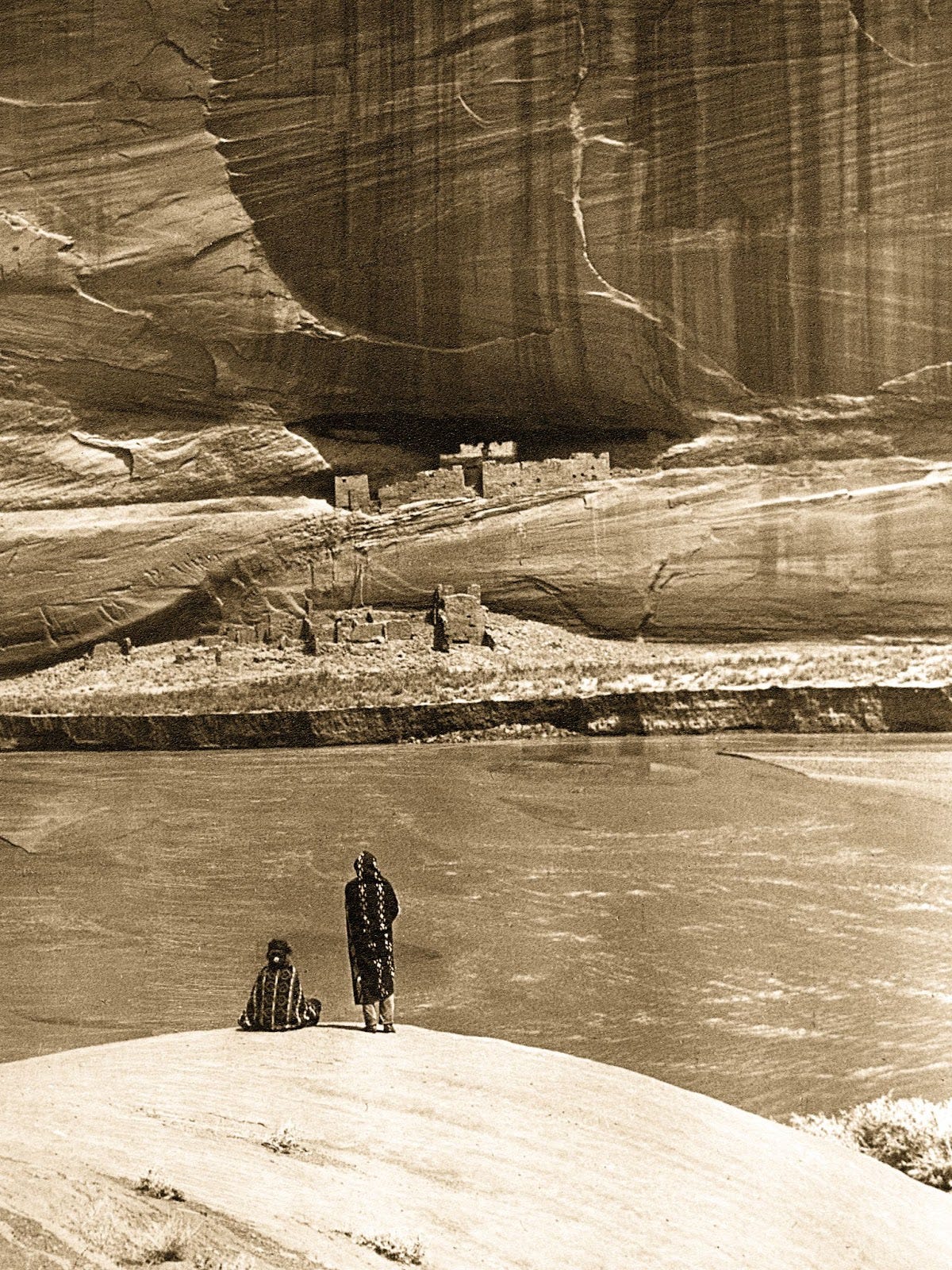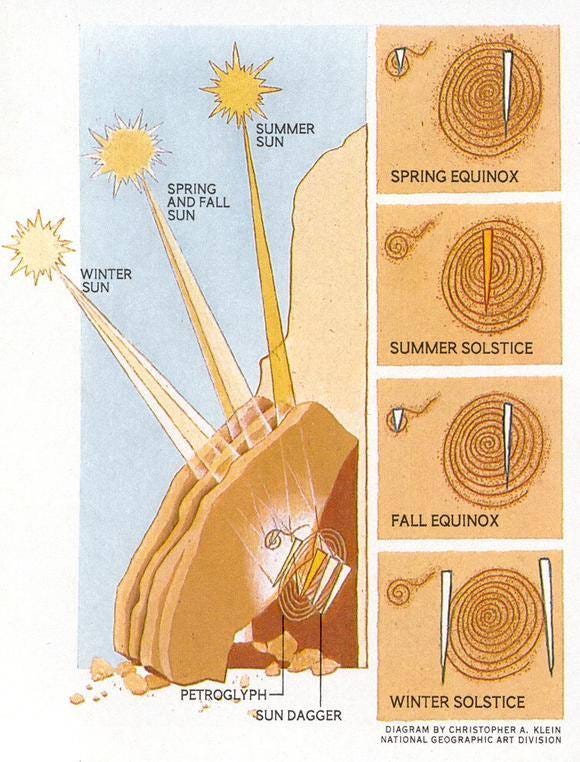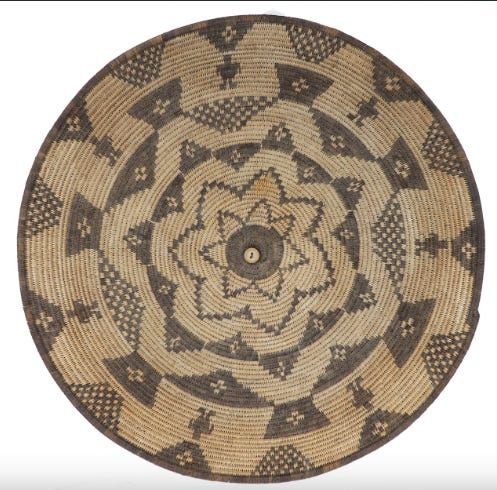The Radiating Sun is the Prime Symbol of the Aridoamerican Plane. As mentioned, it comes from the metaphysical property of standing alone in a massive desert against an indomitable nature. Much of what I have mentioned so far comes from the ethnogenic properties of the Mexican Mestizos in the area, how they perceive and metabolize this symbol, and their urge to paint gigantic radiating murals stemming from it. Similar things can be said of the White Anglos and Hispanics who have also begun to utilize this symbol in new forms, much like William Irwin Thompson’s Lindisfarne Chapel. However, one of the fascinating aspects of this symbol comes from the fact that many of this land's indigenous communities have deep ties to this prime symbol. In this brief article, I will look at the deep and complex ties many of the Southwestern Indigenous people have to this prime symbol.
Alone With The Past - Roland Reed, 1913
Material Culture gives us a deep glance into the essence of the land. The Middle Ages saw various European painters testing the idea of a massive horizon and an Infinite Space. Early Russian art before its pseudomorphosis had a very flat and floral property to it, looking to their Endless Flat Plane. Chinese culture with its obsession with nature paints detailed landscapes. The land shifts the perception of those who live in it, and many of the Southwest’s Indigenous Communities seem to have utilized this world perception in their artistry. It appears in the form of petroglyphs, traditional basketry, their symbols, and pottery. Much like in the current Aridoamerican Plane, there were two ways this Radiating Sun was expressed; that being the Radiating Beams, or through the Spiral/Coil. Many also look to cardinal directions, seasons, and stages of life.
The I’itoi (Man in the maze) of the O’odham is one such great example. In this tradition, you are born from a center, and your journey is based upon radiating outward and returning to this center at various periods in your life, and your death eventually comes from you returning to this center of which the spirit I’itoi returns your soul to the earth. Life ebbs and flows towards the community and away from it, but always returns and many of the bends involve you picking yourself back up from events. In your elderly years, however, you return to this center to teach the next generations as an elder of the tradition. Below this is a comparison with Western Linear Time.
The Zia is another example, which comes from the Zia people. They are a Puebloan Tribe in what is today New Mexico and this symbol has four prongs to represent the rays. Each represents a season, a stage of life, a trait to spiritually balance yourself, and the time of day. This symbol like many of the others, is a balance. In recent years, this symbol has been due to a combination of Indigenization and cultural appropriation has become one of the most famous icons to come from this region and has become the symbol of the New Mexican flag.
The Tapuat comes from the Hopi. It has a similar meaning to that of the O’odham which emphasizes that life is a labyrinth. In this symbol, The life of the child begins as they radiate outwards from a center (Depicted in the form of a Mother) as they perceive more of the world around them. As the end of their life draws near they thus return to this center.
The Spiral/Coil is a more primeval universal symbol that is in practice around multiple cultures such as the Hopi, Puebloans, Dine, Apache, and many other Southwestern Communities. Although many different cultures interpret this symbol in different ways including snakes and water, one common motif across many of these cultures seems to be it symbolizes the life journey and merges the cardinal directions with the journey of life among those who walk down this path. There is a perceived center of this spiral that is considered ideal for spiritual balance with the land. It is depicted in their pottery, how they weave their baskets, and some more ancient societies such as the Chaco culture utilized a spiral to create a solar calendar.
The Lady of Guadeloupe may also be a great example. It may seem strange to utilize a Catholic symbol to reference indigenous traditions, especially when the Spanish Empire was notoriously brutal to many of these communities. It has much to do with the story of her revealing and how she is depicted, how she revealed herself, and the person who saw her rather than its connection to Catholicism. She revealed herself as St. Juan Diego, who was a Nahua, a group of people with a common mythology that states that they come from what is today the Aridoamerican Plane (which is backed by linguistics and genetics). Although they founded the Aztec Empire after their migration into Mesoamerica (with the Tlaxcala, another Nahua group destroying it by siding with the Spanish), how she reveals herself in her miracle, depicts her entire body radiating rather than just the head as many traditions around the world tended to with spiritual depictions of her. Depictions of her whole body radiating light was much rarer in Europe. Although likely just a pure anecdote on my end, this could be both a Christian miracle as well as a calling of the Aridoamerican Plane and a deeper instinct ingrained in the Nahua who saw the Lady.
Yavapai-Apache Basket Circa - 1890
There are many more of these fundamentally similar symbols present among many of the Indigenous communities that make the Aridoamerican Plane home. It percolates into their regalia, dance, art, and many other aspects of their lives. They likely come from the same property as the current form of this Aridoamerican Prime Symbol, the Radiating Sun. This Yavapai-Apache basket synthesizes many of the elements stated. The basket is constructed in a way such that it’s a spiraling coil. While many cultures around the world utilize this basketwork, it likely means something else entirely to these communities due to their connection with spirals. There also is an emphasis on a center which radiates ever outward with its designs. The people are also depicted as much smaller than the basket, likely referencing the sheer scale of the land which they come from in relation to the person. It’s in certain ways, the antithesis thought of the Apollonian Greco-Roman Civilization which shows the body in far closer detail in its pots and statues owing to its Body and Nearby Space.











This post made me think of the spiraled-shaped dances of the rarámuris of Chihuahua. They're manifesting this same radiation with their bodies.